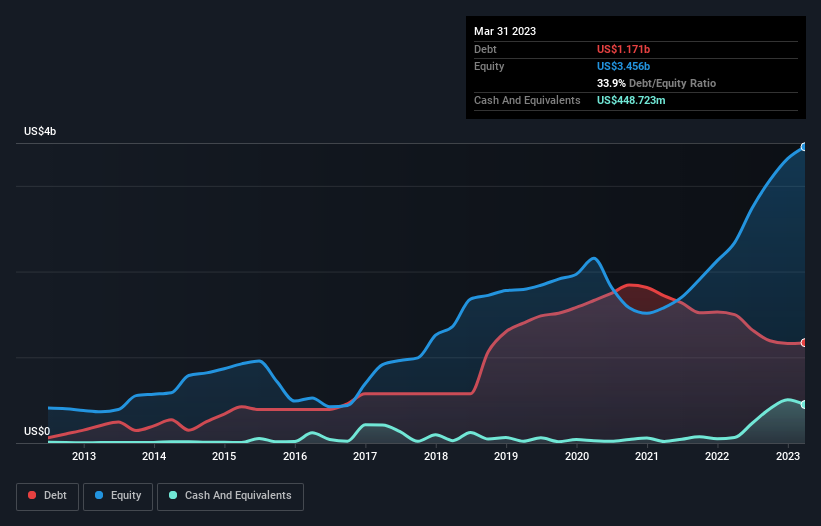- United States
- /
- Oil and Gas
- /
- NYSE:MTDR
We Think Matador Resources (NYSE:MTDR) Can Stay On Top Of Its Debt

Warren Buffett famously said, 'Volatility is far from synonymous with risk.' So it might be obvious that you need to consider debt, when you think about how risky any given stock is, because too much debt can sink a company. We can see that Matador Resources Company (NYSE:MTDR) does use debt in its business. But is this debt a concern to shareholders?
What Risk Does Debt Bring?
Debt is a tool to help businesses grow, but if a business is incapable of paying off its lenders, then it exists at their mercy. In the worst case scenario, a company can go bankrupt if it cannot pay its creditors. While that is not too common, we often do see indebted companies permanently diluting shareholders because lenders force them to raise capital at a distressed price. By replacing dilution, though, debt can be an extremely good tool for businesses that need capital to invest in growth at high rates of return. The first thing to do when considering how much debt a business uses is to look at its cash and debt together.
Check out our latest analysis for Matador Resources
What Is Matador Resources's Net Debt?
The image below, which you can click on for greater detail, shows that Matador Resources had debt of US$1.17b at the end of March 2023, a reduction from US$1.50b over a year. However, because it has a cash reserve of US$448.7m, its net debt is less, at about US$721.8m.

How Healthy Is Matador Resources' Balance Sheet?
The latest balance sheet data shows that Matador Resources had liabilities of US$601.4m due within a year, and liabilities of US$1.72b falling due after that. Offsetting these obligations, it had cash of US$448.7m as well as receivables valued at US$412.9m due within 12 months. So it has liabilities totalling US$1.46b more than its cash and near-term receivables, combined.
This deficit isn't so bad because Matador Resources is worth US$6.05b, and thus could probably raise enough capital to shore up its balance sheet, if the need arose. But we definitely want to keep our eyes open to indications that its debt is bringing too much risk.
We use two main ratios to inform us about debt levels relative to earnings. The first is net debt divided by earnings before interest, tax, depreciation, and amortization (EBITDA), while the second is how many times its earnings before interest and tax (EBIT) covers its interest expense (or its interest cover, for short). Thus we consider debt relative to earnings both with and without depreciation and amortization expenses.
Matador Resources has a low net debt to EBITDA ratio of only 0.33. And its EBIT covers its interest expense a whopping 25.4 times over. So we're pretty relaxed about its super-conservative use of debt. In addition to that, we're happy to report that Matador Resources has boosted its EBIT by 69%, thus reducing the spectre of future debt repayments. There's no doubt that we learn most about debt from the balance sheet. But it is future earnings, more than anything, that will determine Matador Resources's ability to maintain a healthy balance sheet going forward. So if you're focused on the future you can check out this free report showing analyst profit forecasts.
But our final consideration is also important, because a company cannot pay debt with paper profits; it needs cold hard cash. So we clearly need to look at whether that EBIT is leading to corresponding free cash flow. In the last three years, Matador Resources's free cash flow amounted to 38% of its EBIT, less than we'd expect. That's not great, when it comes to paying down debt.
Our View
Happily, Matador Resources's impressive interest cover implies it has the upper hand on its debt. But, on a more sombre note, we are a little concerned by its conversion of EBIT to free cash flow. Taking all this data into account, it seems to us that Matador Resources takes a pretty sensible approach to debt. That means they are taking on a bit more risk, in the hope of boosting shareholder returns. Of course, we wouldn't say no to the extra confidence that we'd gain if we knew that Matador Resources insiders have been buying shares: if you're on the same wavelength, you can find out if insiders are buying by clicking this link.
If you're interested in investing in businesses that can grow profits without the burden of debt, then check out this free list of growing businesses that have net cash on the balance sheet.
New: Manage All Your Stock Portfolios in One Place
We've created the ultimate portfolio companion for stock investors, and it's free.
• Connect an unlimited number of Portfolios and see your total in one currency
• Be alerted to new Warning Signs or Risks via email or mobile
• Track the Fair Value of your stocks
Have feedback on this article? Concerned about the content? Get in touch with us directly. Alternatively, email editorial-team (at) simplywallst.com.
This article by Simply Wall St is general in nature. We provide commentary based on historical data and analyst forecasts only using an unbiased methodology and our articles are not intended to be financial advice. It does not constitute a recommendation to buy or sell any stock, and does not take account of your objectives, or your financial situation. We aim to bring you long-term focused analysis driven by fundamental data. Note that our analysis may not factor in the latest price-sensitive company announcements or qualitative material. Simply Wall St has no position in any stocks mentioned.
About NYSE:MTDR
Matador Resources
An independent energy company, engages in the acquisition, exploration, development, and production of oil and natural gas resources in the United States.
Very undervalued with acceptable track record.
Similar Companies
Market Insights
Community Narratives



